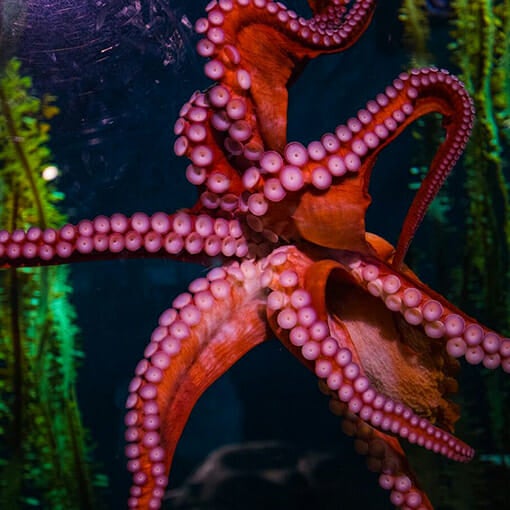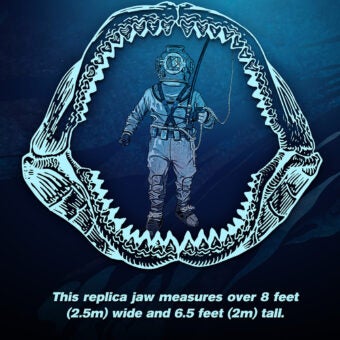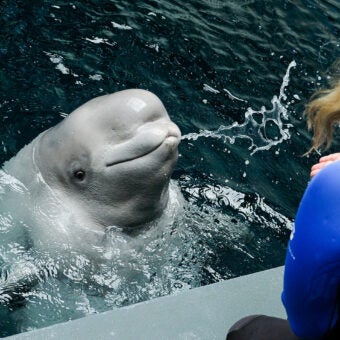-
Size
13 feet (4 m) in length -
Diet
Crustaceans, mollusks, fish and smaller octopods -
Range
Pacific coast -
Habitat
Shallow tidal pools to ocean depths of about 4,920 feet (1500 m)
Physical Characteristics
- The giant Pacific octopus is usually reddish-brown in color.
- The average size is 7-14 feet (2.1-4 m) in length from arm tip to arm tip.
- An average adult can weigh 50 lbs. (22.7 kg).
- This species tends to be small when it lives in warmer water and larger in colder waters, such as the North Pacific.
- It has eight arms attached to its body. Each arm has two rows of suckers and there may be as many as 250 suckers on each one.
- This is the largest species of octopus with a record size of 600 lbs. (181 kg) and a 30-foot (7.6 m) arm span.
- The body of the octopus is bulb-shaped and contains all of the octopus’ organs and its mouth. The mouth is located on the underside, where the arms converge. In the center of the mouth is a beak that is made of keratin, the same substance that is in the human fingernail and the rhinoceros horn. The beak is used to kill its prey and bite it into pieces prior to swallowing.
Animal Fun Fact
The giant Pacific octopus can have up to 250 suckers on each arm.
Diet / Feeding
- The young giant Pacific octopus feeds on dead animals and is characterized as a “neustonic feeder.”
- Adult preys on crustaceans, such as shrimp, crabs, scallops, clams, as well as other mollusks, flatfishes, redfish and smaller octopods.
Range / Habitat
- The giant Pacific octopus occurs along the Pacific coast from Southern California to Alaska and across to Japan.
- It is found in habitats that range from shallow tidal pools to ocean depths of about 4,920 feet (1500 m). It is most abundant in shallow waters to 16 feet (5 m) deep.
Reproduction & Growth
- Female giant Pacific octopus can lay between 18,000 to 100,000 eggs. The eggs are placed on rocks or sandy bottoms at depths less than 164 feet (50 m). She will protect them for about six months from other animals, such as sea stars and crabs. During this time, she will not eat.
- The giant Pacific octopus reproduces in the fall.
- Individuals usually will mate only once.
- After mating, the male will move into deep water and die. The female will die after her eggs hatch.
Conservation Status
- “Least Concern” on the IUCN Red List.
Additional Information
- Seals, sea otters, sharks, and large fish are the predominant predators of the giant Pacific octopus.
- The giant Pacific octopus is an intelligent animal with a well-developed brain. In laboratory tests and aquariums, it has been able to solve mazes very quickly and can unscrew jar lids to retrieve food inside.
- It has acute vision and a sensitive sense of taste in its suckers.
- The giant Pacific octopus lives longer than other species of octopus. Males live about 5 years and females about 3.5 years.
- At rest, the octopus’ skin is smooth with a reddish-brown coloration. When it becomes excited, it can quickly change the color and texture of its skin by contracting skin cells filled with pigment. This ability allows it to camouflage itself when hunting prey. It is also a major method of avoiding predators.
- This animal is of major commercial importance and is the most common species caught by fisheries in northern Japan, with about 20,000 metric tons taken each year.
- Fisheries for this species exist in Alaska and Washington.
- The octopus is a mollusk and belongs to the same group as snails, chitons, abalone, limpets, clams, scallops, oysters, and mussels. The octopus also belongs to a smaller subgroup of mollusks called “cephalopods”, which means, “head-foot.” It is so named because its arms (“feet”) are attached to its head. Cuttlefish and squid are also classified as cephalopods.
- These animals can rapidly draw water into the mantle and expel it forcefully out of their body. This propels them swiftly backward helping to escape predators.
- Cephalopods also can release a cloud of dark ink when alarmed, which also helps them avoid predation.
Sources
- www.animaldiversity.org
- www.monteraybayaquarium.org
- www.marinebio.org
- Cephalopods – A World Guide. Norman, M., pg. 214
-







